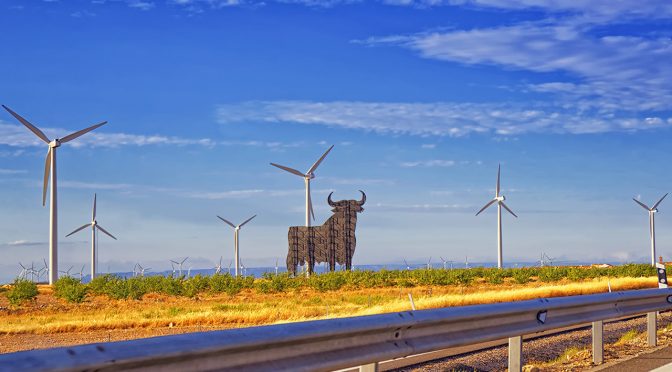Although their importance was greatly overshadowed by the gas and CO2 price crisis, renewable energies continued to grow at a very high rate during this year 2021. With these technologies, capable of generating electricity without greenhouse gas emissions and essential in the energy transition, begins a summary of the most important events that happened in this year 2021 in the energy sector in Spain and Europe.
The surprising year 2021
The year 2021 is coming to an end. After how extraordinary 2020 was in every way, but also for the energy sector, it seemed that 2021 was going to be the year that would bring back a certain normality. Nothing is further from reality. 2021 looks set to be the most extraordinary year for energy markets for many years, if not decades, to come.
In a series of articles, AleaSoft Energy Forecasting is going to analyse different aspects of the energy sector during this year 2021. In this first instalment, we will take a look at renewable energies during this period.
The situation of renewable energies in Spain in 2021
The global crisis of 2020 was not able to stop the explosion registered by renewable energies in 2019 and which continued during this 2021. This growth of renewable energies was led by wind energy and photovoltaic energy, being the only two technologies that grew in a significant way.
Source: Prepared by AleaSoft Energy Forecasting using data from REE.
Even with provisional data from Red Eléctrica de España (REE), during 2021, 493 MW of wind energy capacity and 2.1 GW of photovoltaic energy capacity were installed in the Spanish peninsular territory. This represents a growth of 1.8% for wind power and 19% for photovoltaic energy. In all renewable energies as a whole, the increase in installed capacity was 2.6 GW, a growth of 4.2%. These increases in capacity put the installed wind energy capacity at 27.5 GW, the photovoltaic energy capacity at 13.6 GW and the total of renewable energies at 65.0 GW.
This explosion of renewable energies and their continuous growth in recent years placed Spain in the world’s top ten of countries with renewable energies again. In addition, as it is logical, throughout the year, records of renewable energy production, especially of photovoltaic energy, were broken as the new installed capacity came into operation.
Towards the NECP’s targets
The Integrated National Energy and Climate Plan aims to reach 50 GW of wind energy capacity and 39 GW of photovoltaic energy capacity installed at a national level in 2030. Achieving these objectives from the current situation will mean an installation rate of more than 200 MW of wind energy and more than 230 MW of photovoltaic energy every month until 2030. The target is ambitious, but not unattainable. What is clear is that it will require a very important investment.
Source: Prepared by AleaSoft Energy Forecasting using data from REE and the MITECO.
According to the economic impact study of the NECP prepared by the Government itself, to develop all this new wind and photovoltaic energy capacity a total investment of more than 41 billion Euros will be required. Looking at REE data, to put into operation all the wind and photovoltaic energy capacity that currently has a granted access permit, around 140 GW, around 100 billion Euros would be needed. This need for capital is already attracting many international investment funds that see Spain as one of the most attractive markets to invest in.
The impact of renewable energies on the electricity market
A growth in renewable energies as significant as that expected will undoubtedly have a significant impact on electricity markets and their prices. It is known that renewable energies exert downward pressure on market prices due to their limited capacity to manage their production.
But not only renewable energies are going to influence electricity markets prices. Also energy storage technologies, which will play an essential role in the energy transition, the hybridisation and complementarity between renewable technologies and the production of clean fuels such as green hydrogen.
Renewable energies in the decarbonisation of the economy
Targets of renewable energy capacity and CO2 and other greenhouse gases emissions reduction by 2030 are only the first step in a major energy transition to bring the economy to net zero emissions by 2050. In other words, a completely decarbonised economy in less than three decades.
In this challenge of the decarbonisation, it is important to highlight that the electricity sector is committed and is making steady progress towards achieving its objectives. But there are other more polluting sectors that will also have to adopt renewable energies and for which the challenges are even more difficult. Sectors such as transport or industry currently rely largely on fossil fuels. Their transition to clean energy and fuels is challenging.
AleaSoft Energy Forecasting’s analysis on the prospects for energy markets in Europe
Investments in renewable energy projects require a robust financial model that ensures an optimal return on investment. An essential input of the financial model is the long?term market price forecasting, which must have hourly granularity to estimate the potential revenues of the generation plant throughout its lifetime.
To analyse the prospects for the energy markets in Europe for the year 2022, AleaSoft Energy Forecasting is organising what will be the first webinar in 2022 of its series of monthly webinars. The webinar will take place on January 13 and will include the participation of speakers from PwC Spain, who will analyse how the regulatory and electricity market situation impacts the development of PPA, both off?site and on?site.



